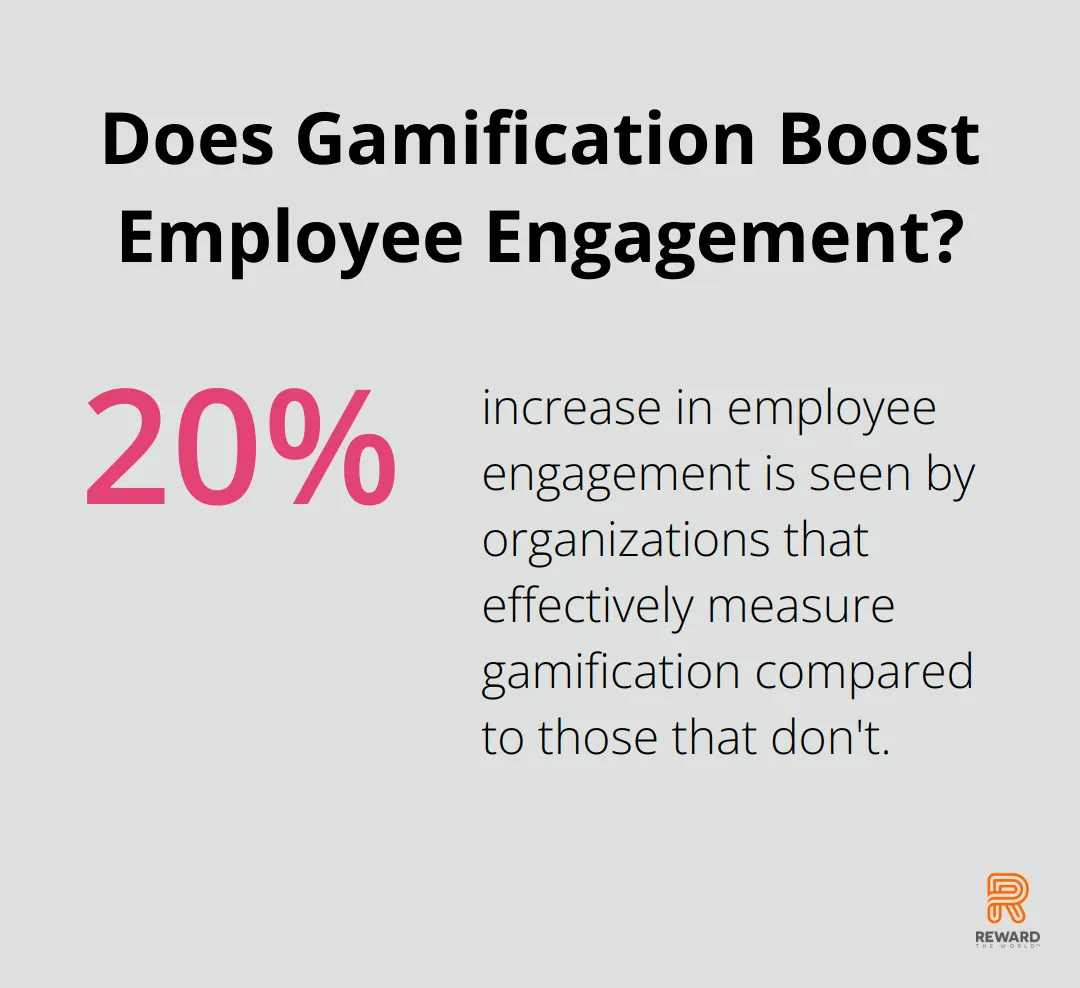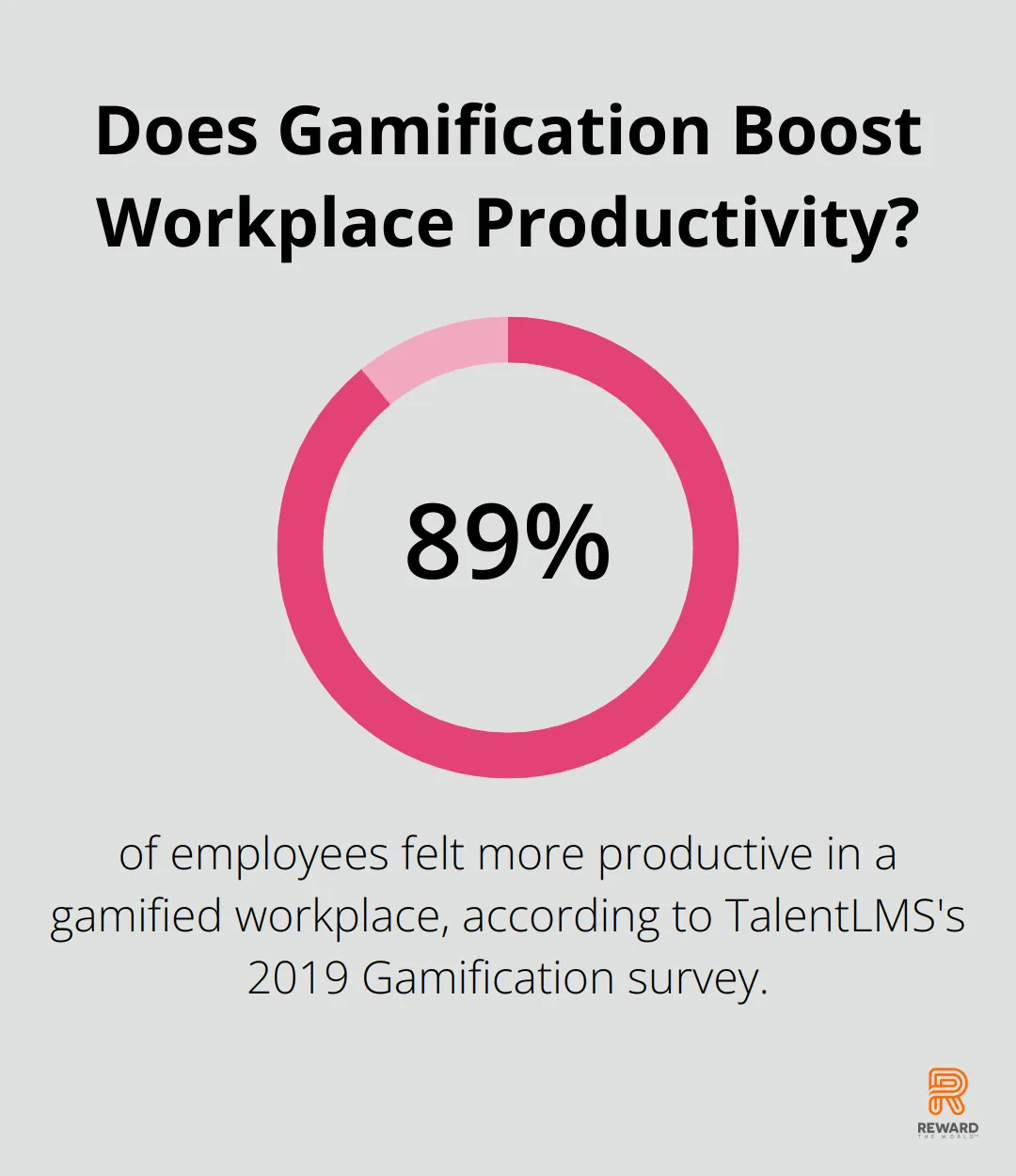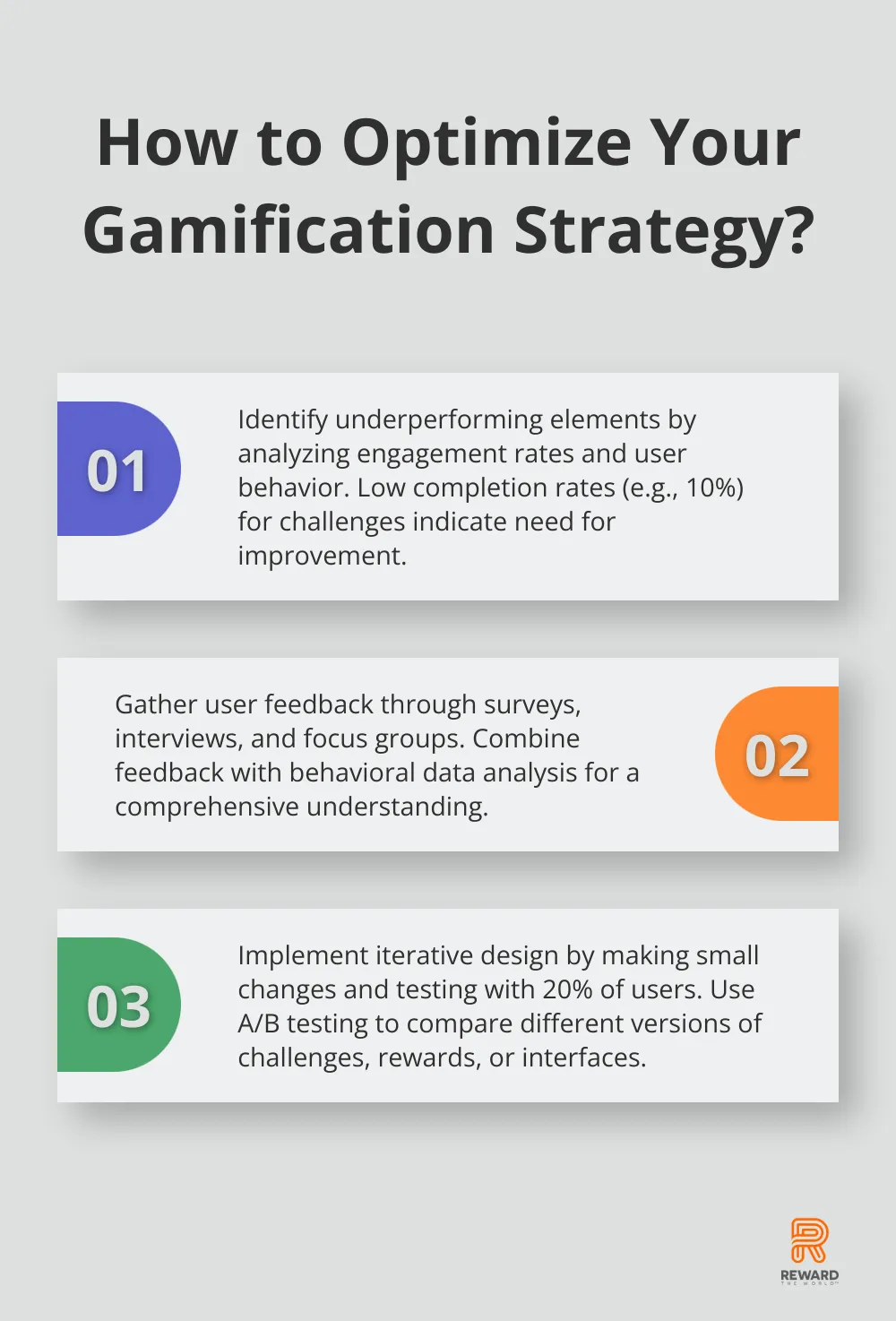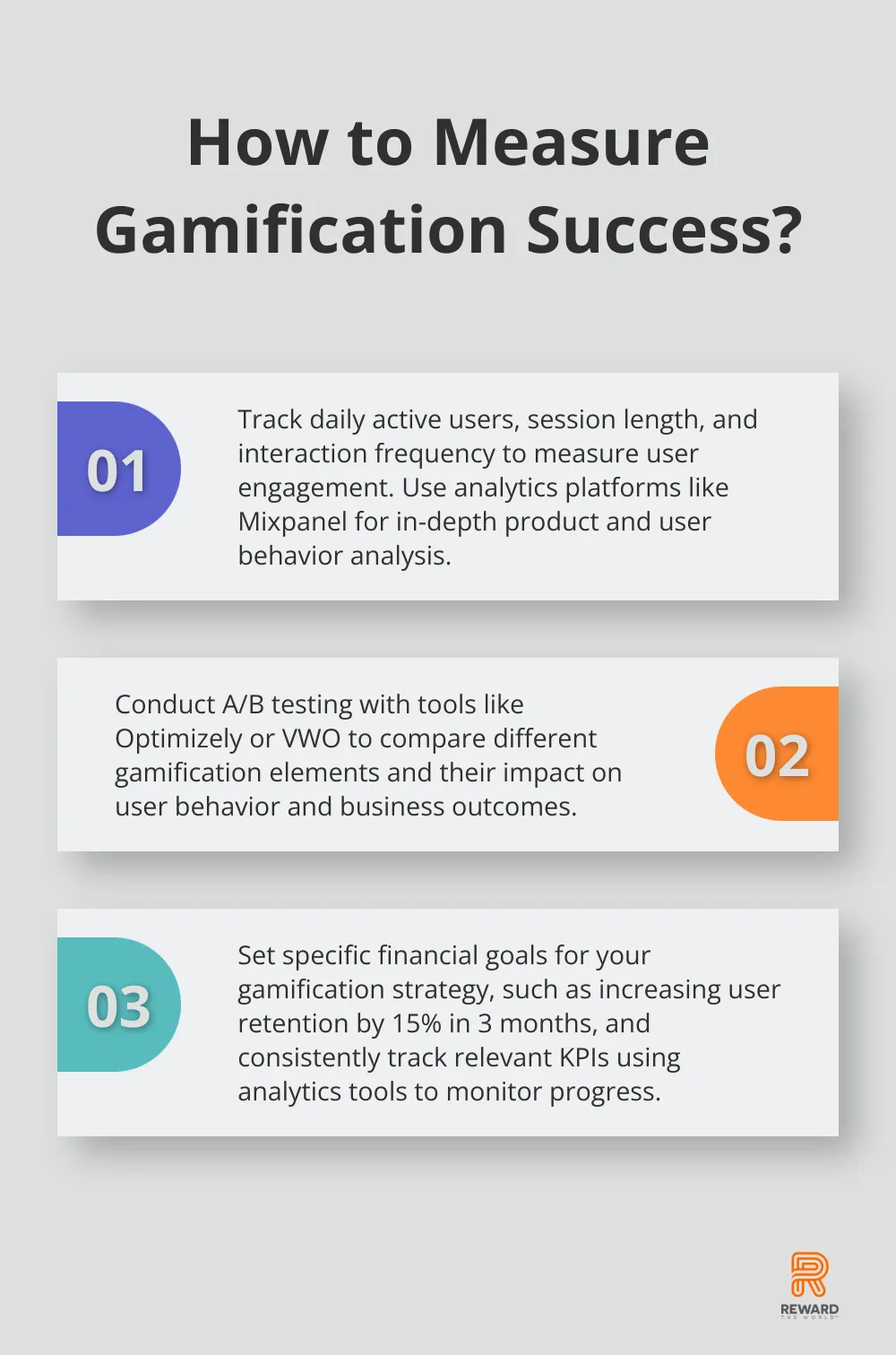
Gamification has become a popular strategy for businesses to boost engagement and productivity. But how do you know if your gamification efforts are actually paying off?
At Reward the World, we’ve seen first hand the impact of well-implemented gamification strategies. However, measuring the success and calculating the gamification ROI can be challenging.
In this post, we’ll explore how to evaluate your gamification initiatives and make data-driven improvements for better results.
How to Measure Gamification Success
Tracking Essential KPIs
To evaluate the effectiveness of your gamification strategy, focus on these key performance indicators:
- User Engagement: Monitor daily active users, session length, and interaction frequency.
- Task Completion Rates: Measure the percentage of users who complete gamified tasks or challenges.
- Conversion Rates: Track how gamification impacts desired actions (e.g., purchases or sign-ups).
- Retention Rates: Analyze gamification’s effect on user retention over time.
- User Satisfaction: Collect feedback through surveys or Net Promoter Score (NPS) to assess user sentiment.

A Gartner study found that organizations which effectively measure gamification see a 20% increase in employee engagement compared to those that don’t.
Leveraging Data Collection Tools
To gather and analyze gamification data effectively, consider these tools:
- Analytics Platforms: Mixpanel is better suited for in-depth product and user behavior analytics, while Google Analytics excels at tracking website traffic and overall marketing performance.
- A/B Testing Tools: Optimizely or VWO allow you to compare different gamification elements and their impact.
- Heatmap Tools: Hotjar or Crazy Egg help visualize user interactions with gamified elements.
- Feedback Collection: SurveyMonkey or Typeform gather qualitative data from users.
Avoiding Common Measurement Pitfalls
When measuring gamification success, watch out for these common mistakes:
- Focusing solely on vanity metrics: Don’t get caught up in superficial numbers (like total users). Instead, prioritize actionable metrics that directly relate to your business goals.
- Neglecting long-term impact: Short-term engagement matters, but also assess how gamification affects user behavior and business outcomes over extended periods.
- Ignoring user segments: Different user groups may respond differently to gamification. Analyze performance across various segments to gain a more nuanced understanding.
- Overlooking qualitative data: While quantitative metrics matter, don’t forget to collect and analyze qualitative feedback to understand the “why” behind the numbers.
- Failing to align metrics with business objectives: Ensure that the KPIs you track directly relate to your overall business goals.
Implementing a Comprehensive Measurement Strategy
To create a robust measurement strategy for your gamification efforts:
- Set clear objectives: Define specific, measurable goals for your gamification initiative (e.g., increase user retention by 15% in 3 months).
- Choose relevant metrics: Select KPIs that align with your objectives and provide actionable insights.
- Establish a baseline: Measure your current performance before implementing gamification to accurately assess its impact.
- Use a mix of quantitative and qualitative data: Combine hard numbers with user feedback for a complete picture.
- Regularly analyze key performance indicators (KPIs) to gauge success and identify areas for improvement.
With a solid measurement strategy in place, you’ll be well-equipped to evaluate the ROI of your gamification initiatives. Let’s explore how to calculate the financial returns and assess the broader benefits of your gamification efforts.
How Much Is Your Gamification Strategy Worth?
Quantifying Direct Financial Returns
To measure the direct financial impact of your gamification strategy, focus on metrics that directly tie to revenue or cost savings:
- Increased sales: Compare conversion rates and average order values before and after gamification implementation.
- Reduced customer acquisition costs: Measure how gamification impacts your marketing spend per new customer.
- Improved employee productivity: Calculate the value of increased output or efficiency from gamified work processes.

The gamification market is currently valued at $15.43 billion and is projected to grow to $48.72 billion by 2029, indicating strong business confidence in gamification’s value.
Uncovering Hidden Benefits
While direct financial returns matter, don’t overlook the indirect benefits of gamification:
- Enhanced brand loyalty: Measure increases in customer lifetime value and repeat purchase rates.
- Improved employee retention: Calculate the savings from reduced turnover and training costs.
- Increased word-of-mouth marketing: Track referrals and social media mentions resulting from gamified experiences.
Research from TalentLMS shows that 89% of employees felt more productive in a gamified workplace, according to their 2019 Gamification survey. These improvements in employee satisfaction can lead to significant long-term benefits for your organization.
Balancing Costs and Benefits
To get a complete picture of your gamification ROI, consider all associated costs:
- Development and implementation expenses
- Ongoing maintenance and updates
- Staff training and support
- Rewards or incentives offered through the gamified system
Compare these costs against both the direct financial returns and the estimated value of indirect benefits. Some benefits (like improved brand perception) may take time to materialize fully.
A comprehensive ROI analysis helps justify your gamification investment and identifies areas for improvement. If you find that certain gamified elements don’t deliver expected returns, you can reallocate resources to more effective strategies.
Optimizing Your Gamification ROI
To maximize the value of your gamification efforts:
- Set clear financial goals: Define specific revenue targets or cost-saving objectives for your gamification strategy.
- Track metrics consistently: Use analytics tools to monitor key performance indicators (KPIs) over time.
- Experiment with different approaches: Try A/B testing various gamification elements to identify the most effective tactics.
- Gather user feedback: Conduct surveys or interviews to understand how participants perceive the value of your gamified experiences.
As you refine your approach based on data and user insights, you’ll likely see even greater returns on your gamification investment. The next step is to adjust your strategy for optimal results.
How to Improve Your Gamification Strategy
Identify Underperforming Elements
Start by pinpointing elements that don’t meet expectations. Look for:
- Low engagement rates with specific game mechanics
- Challenges users frequently abandon
- Rewards that fail to motivate desired behaviors

If only 10% of users complete a particular challenge, it signals a need for change. The challenge might be too difficult, or the reward might lack appeal.
Use heat maps and user journey analysis to locate drop-off points. Tools can reveal which gamified elements users interact with most and which they ignore.
Incorporate User Feedback
User feedback provides valuable insights for improving your gamification strategy. Conduct regular surveys, interviews, and focus groups. Ask specific questions about:
- Game elements users find most engaging
- Motivations for participation
- Frustrations or barriers encountered
Don’t rely solely on what users say – observe their actions. Analyze behavioral data alongside feedback for a complete picture. Users might claim to love a certain reward but rarely choose it, indicating a disconnect between perceived and actual value.
Implement Iterative Design
Gamification requires ongoing refinement. Adopt an iterative approach:
- Make small, targeted changes based on data and feedback
- Test these changes with a subset of users
- Measure the impact
- Implement successful changes more broadly
If users complain about complex rules, simplify one aspect of your gamification system and test it with 20% of your user base. If engagement improves, roll out the change to all users.
A/B testing proves invaluable here. Try different versions of challenges, rewards, or user interfaces to determine what resonates best. Tools can help you run these experiments efficiently.
Different audiences may respond differently to gamification elements. Tailor your approach to various user segments. Research suggests that gamification may increase individuals’ engagement and promote learning.
Stay Current with Trends
What worked last year might not be as effective today. The rise of augmented reality (AR), for example, opens up new possibilities for location-based challenges and rewards. With integrated game-like features, users can participate in interactive challenges, complete quests, and earn rewards as they explore different destinations.
Continuously analyze, listen, and adapt to ensure your gamification strategy remains effective and engaging. View gamification as a dynamic tool that evolves with your users and business goals.
Final Thoughts
Measuring gamification success requires tracking key performance indicators and leveraging data collection tools. Companies must avoid common pitfalls and implement comprehensive measurement strategies to gain valuable insights. Gamification ROI calculations help justify investments and identify areas for improvement in business strategies.

Enhancing gamification strategies involves identifying underperforming elements, incorporating user feedback, and implementing iterative design. Regular data analysis and strategy adjustments based on user behavior and preferences prove essential. Different user segments may respond uniquely to gamification elements, necessitating tailored approaches.
Reward the World offers a powerful solution for businesses seeking to implement or improve their gamification strategies. With global reach and instant reward delivery, our platform can help elevate customer engagement through effective gamification techniques. The future of gamification in business looks promising, with new technologies opening up exciting possibilities for engaging users.
